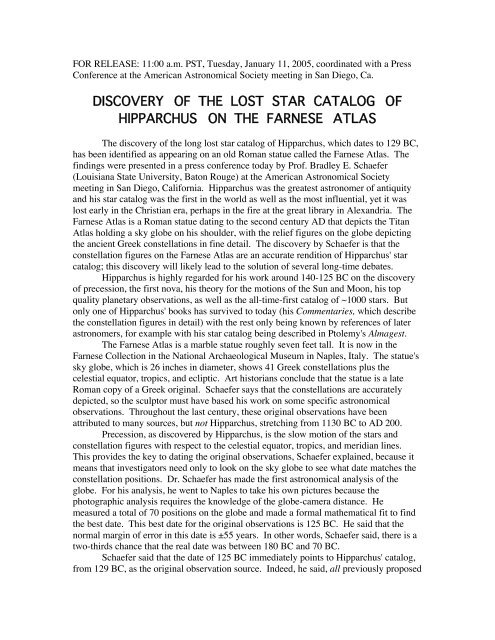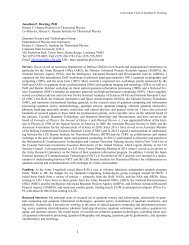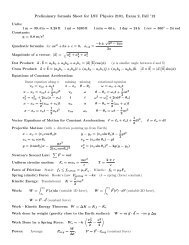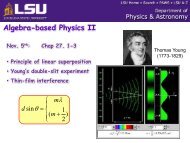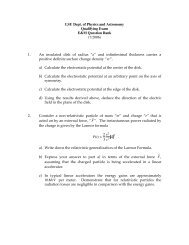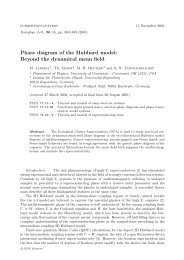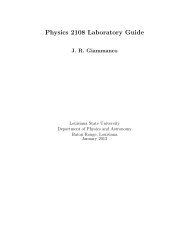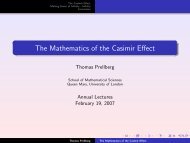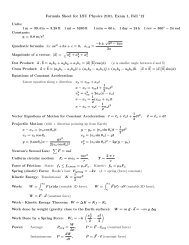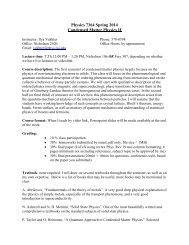discovery of the lost star catalog of hipparchus on the farnese atlas
discovery of the lost star catalog of hipparchus on the farnese atlas
discovery of the lost star catalog of hipparchus on the farnese atlas
You also want an ePaper? Increase the reach of your titles
YUMPU automatically turns print PDFs into web optimized ePapers that Google loves.
FOR RELEASE: 11:00 a.m. PST, Tuesday, January 11, 2005, coordinated with a Press<br />
C<strong>on</strong>ference at <str<strong>on</strong>g>the</str<strong>on</strong>g> American Astr<strong>on</strong>omical Society meeting in San Diego, Ca.<br />
DISCOVERY OF THE LOST STAR CATALOG OF<br />
HIPPARCHUS ON THE FARNESE ATLAS<br />
The <str<strong>on</strong>g>discovery</str<strong>on</strong>g> <str<strong>on</strong>g>of</str<strong>on</strong>g> <str<strong>on</strong>g>the</str<strong>on</strong>g> l<strong>on</strong>g <str<strong>on</strong>g>lost</str<strong>on</strong>g> <str<strong>on</strong>g>star</str<strong>on</strong>g> <str<strong>on</strong>g>catalog</str<strong>on</strong>g> <str<strong>on</strong>g>of</str<strong>on</strong>g> Hipparchus, which dates to 129 BC,<br />
has been identified as appearing <strong>on</strong> an old Roman statue called <str<strong>on</strong>g>the</str<strong>on</strong>g> Farnese Atlas. The<br />
findings were presented in a press c<strong>on</strong>ference today by Pr<str<strong>on</strong>g>of</str<strong>on</strong>g>. Bradley E. Schaefer<br />
(Louisiana State University, Bat<strong>on</strong> Rouge) at <str<strong>on</strong>g>the</str<strong>on</strong>g> American Astr<strong>on</strong>omical Society<br />
meeting in San Diego, California. Hipparchus was <str<strong>on</strong>g>the</str<strong>on</strong>g> greatest astr<strong>on</strong>omer <str<strong>on</strong>g>of</str<strong>on</strong>g> antiquity<br />
and his <str<strong>on</strong>g>star</str<strong>on</strong>g> <str<strong>on</strong>g>catalog</str<strong>on</strong>g> was <str<strong>on</strong>g>the</str<strong>on</strong>g> first in <str<strong>on</strong>g>the</str<strong>on</strong>g> world as well as <str<strong>on</strong>g>the</str<strong>on</strong>g> most influential, yet it was<br />
<str<strong>on</strong>g>lost</str<strong>on</strong>g> early in <str<strong>on</strong>g>the</str<strong>on</strong>g> Christian era, perhaps in <str<strong>on</strong>g>the</str<strong>on</strong>g> fire at <str<strong>on</strong>g>the</str<strong>on</strong>g> great library in Alexandria. The<br />
Farnese Atlas is a Roman statue dating to <str<strong>on</strong>g>the</str<strong>on</strong>g> sec<strong>on</strong>d century AD that depicts <str<strong>on</strong>g>the</str<strong>on</strong>g> Titan<br />
Atlas holding a sky globe <strong>on</strong> his shoulder, with <str<strong>on</strong>g>the</str<strong>on</strong>g> relief figures <strong>on</strong> <str<strong>on</strong>g>the</str<strong>on</strong>g> globe depicting<br />
<str<strong>on</strong>g>the</str<strong>on</strong>g> ancient Greek c<strong>on</strong>stellati<strong>on</strong>s in fine detail. The <str<strong>on</strong>g>discovery</str<strong>on</strong>g> by Schaefer is that <str<strong>on</strong>g>the</str<strong>on</strong>g><br />
c<strong>on</strong>stellati<strong>on</strong> figures <strong>on</strong> <str<strong>on</strong>g>the</str<strong>on</strong>g> Farnese Atlas are an accurate renditi<strong>on</strong> <str<strong>on</strong>g>of</str<strong>on</strong>g> Hipparchus' <str<strong>on</strong>g>star</str<strong>on</strong>g><br />
<str<strong>on</strong>g>catalog</str<strong>on</strong>g>; this <str<strong>on</strong>g>discovery</str<strong>on</strong>g> will likely lead to <str<strong>on</strong>g>the</str<strong>on</strong>g> soluti<strong>on</strong> <str<strong>on</strong>g>of</str<strong>on</strong>g> several l<strong>on</strong>g-time debates.<br />
Hipparchus is highly regarded for his work around 140-125 BC <strong>on</strong> <str<strong>on</strong>g>the</str<strong>on</strong>g> <str<strong>on</strong>g>discovery</str<strong>on</strong>g><br />
<str<strong>on</strong>g>of</str<strong>on</strong>g> precessi<strong>on</strong>, <str<strong>on</strong>g>the</str<strong>on</strong>g> first nova, his <str<strong>on</strong>g>the</str<strong>on</strong>g>ory for <str<strong>on</strong>g>the</str<strong>on</strong>g> moti<strong>on</strong>s <str<strong>on</strong>g>of</str<strong>on</strong>g> <str<strong>on</strong>g>the</str<strong>on</strong>g> Sun and Mo<strong>on</strong>, his top<br />
quality planetary observati<strong>on</strong>s, as well as <str<strong>on</strong>g>the</str<strong>on</strong>g> all-time-first <str<strong>on</strong>g>catalog</str<strong>on</strong>g> <str<strong>on</strong>g>of</str<strong>on</strong>g> ~1000 <str<strong>on</strong>g>star</str<strong>on</strong>g>s. But<br />
<strong>on</strong>ly <strong>on</strong>e <str<strong>on</strong>g>of</str<strong>on</strong>g> Hipparchus' books has survived to today (his Commentaries, which describe<br />
<str<strong>on</strong>g>the</str<strong>on</strong>g> c<strong>on</strong>stellati<strong>on</strong> figures in detail) with <str<strong>on</strong>g>the</str<strong>on</strong>g> rest <strong>on</strong>ly being known by references <str<strong>on</strong>g>of</str<strong>on</strong>g> later<br />
astr<strong>on</strong>omers, for example with his <str<strong>on</strong>g>star</str<strong>on</strong>g> <str<strong>on</strong>g>catalog</str<strong>on</strong>g> being described in Ptolemy's Almagest.<br />
The Farnese Atlas is a marble statue roughly seven feet tall. It is now in <str<strong>on</strong>g>the</str<strong>on</strong>g><br />
Farnese Collecti<strong>on</strong> in <str<strong>on</strong>g>the</str<strong>on</strong>g> Nati<strong>on</strong>al Archaeological Museum in Naples, Italy. The statue's<br />
sky globe, which is 26 inches in diameter, shows 41 Greek c<strong>on</strong>stellati<strong>on</strong>s plus <str<strong>on</strong>g>the</str<strong>on</strong>g><br />
celestial equator, tropics, and ecliptic. Art historians c<strong>on</strong>clude that <str<strong>on</strong>g>the</str<strong>on</strong>g> statue is a late<br />
Roman copy <str<strong>on</strong>g>of</str<strong>on</strong>g> a Greek original. Schaefer says that <str<strong>on</strong>g>the</str<strong>on</strong>g> c<strong>on</strong>stellati<strong>on</strong>s are accurately<br />
depicted, so <str<strong>on</strong>g>the</str<strong>on</strong>g> sculptor must have based his work <strong>on</strong> some specific astr<strong>on</strong>omical<br />
observati<strong>on</strong>s. Throughout <str<strong>on</strong>g>the</str<strong>on</strong>g> last century, <str<strong>on</strong>g>the</str<strong>on</strong>g>se original observati<strong>on</strong>s have been<br />
attributed to many sources, but not Hipparchus, stretching from 1130 BC to AD 200.<br />
Precessi<strong>on</strong>, as discovered by Hipparchus, is <str<strong>on</strong>g>the</str<strong>on</strong>g> slow moti<strong>on</strong> <str<strong>on</strong>g>of</str<strong>on</strong>g> <str<strong>on</strong>g>the</str<strong>on</strong>g> <str<strong>on</strong>g>star</str<strong>on</strong>g>s and<br />
c<strong>on</strong>stellati<strong>on</strong> figures with respect to <str<strong>on</strong>g>the</str<strong>on</strong>g> celestial equator, tropics, and meridian lines.<br />
This provides <str<strong>on</strong>g>the</str<strong>on</strong>g> key to dating <str<strong>on</strong>g>the</str<strong>on</strong>g> original observati<strong>on</strong>s, Schaefer explained, because it<br />
means that investigators need <strong>on</strong>ly to look <strong>on</strong> <str<strong>on</strong>g>the</str<strong>on</strong>g> sky globe to see what date matches <str<strong>on</strong>g>the</str<strong>on</strong>g><br />
c<strong>on</strong>stellati<strong>on</strong> positi<strong>on</strong>s. Dr. Schaefer has made <str<strong>on</strong>g>the</str<strong>on</strong>g> first astr<strong>on</strong>omical analysis <str<strong>on</strong>g>of</str<strong>on</strong>g> <str<strong>on</strong>g>the</str<strong>on</strong>g><br />
globe. For his analysis, he went to Naples to take his own pictures because <str<strong>on</strong>g>the</str<strong>on</strong>g><br />
photographic analysis requires <str<strong>on</strong>g>the</str<strong>on</strong>g> knowledge <str<strong>on</strong>g>of</str<strong>on</strong>g> <str<strong>on</strong>g>the</str<strong>on</strong>g> globe-camera distance. He<br />
measured a total <str<strong>on</strong>g>of</str<strong>on</strong>g> 70 positi<strong>on</strong>s <strong>on</strong> <str<strong>on</strong>g>the</str<strong>on</strong>g> globe and made a formal ma<str<strong>on</strong>g>the</str<strong>on</strong>g>matical fit to find<br />
<str<strong>on</strong>g>the</str<strong>on</strong>g> best date. This best date for <str<strong>on</strong>g>the</str<strong>on</strong>g> original observati<strong>on</strong>s is 125 BC. He said that <str<strong>on</strong>g>the</str<strong>on</strong>g><br />
normal margin <str<strong>on</strong>g>of</str<strong>on</strong>g> error in this date is ±55 years. In o<str<strong>on</strong>g>the</str<strong>on</strong>g>r words, Schaefer said, <str<strong>on</strong>g>the</str<strong>on</strong>g>re is a<br />
two-thirds chance that <str<strong>on</strong>g>the</str<strong>on</strong>g> real date was between 180 BC and 70 BC.<br />
Schaefer said that <str<strong>on</strong>g>the</str<strong>on</strong>g> date <str<strong>on</strong>g>of</str<strong>on</strong>g> 125 BC immediately points to Hipparchus' <str<strong>on</strong>g>catalog</str<strong>on</strong>g>,<br />
from 129 BC, as <str<strong>on</strong>g>the</str<strong>on</strong>g> original observati<strong>on</strong> source. Indeed, he said, all previously proposed
candidates are c<strong>on</strong>fidently eliminated. That is, Aratus around 275 BC, Eudoxus around<br />
366 BC, and <str<strong>on</strong>g>the</str<strong>on</strong>g> Assyrian observer around 1130 BC are all much too early while Ptolemy<br />
around AD 128 is much too late.<br />
The positi<strong>on</strong>ing <str<strong>on</strong>g>of</str<strong>on</strong>g> <str<strong>on</strong>g>the</str<strong>on</strong>g> c<strong>on</strong>stellati<strong>on</strong> figures <strong>on</strong> <str<strong>on</strong>g>the</str<strong>on</strong>g> Farnese Atlas has a typical<br />
accuracy <str<strong>on</strong>g>of</str<strong>on</strong>g> 3.5 degrees. Schaefer says that such an accuracy is essentially impossible to<br />
be achieved by simple verbal descripti<strong>on</strong>s, such as given by Aratus or Eudoxus, which<br />
are accurate to ~8 degrees. However, ancient <str<strong>on</strong>g>star</str<strong>on</strong>g> <str<strong>on</strong>g>catalog</str<strong>on</strong>g>s easily have <str<strong>on</strong>g>the</str<strong>on</strong>g> required<br />
accuracy. Hipparchus is known to have a <str<strong>on</strong>g>star</str<strong>on</strong>g> <str<strong>on</strong>g>catalog</str<strong>on</strong>g> <str<strong>on</strong>g>of</str<strong>on</strong>g> <str<strong>on</strong>g>the</str<strong>on</strong>g> right date, 129 BC, whereas<br />
<str<strong>on</strong>g>the</str<strong>on</strong>g> next <str<strong>on</strong>g>catalog</str<strong>on</strong>g>, created by Ptolemy, came much too late, in AD 128. Hipparchus is<br />
known to have c<strong>on</strong>structed many sky globes based <strong>on</strong> his <str<strong>on</strong>g>star</str<strong>on</strong>g> <str<strong>on</strong>g>catalog</str<strong>on</strong>g>. For instance,<br />
ancient coins depict Hipparchus seated in fr<strong>on</strong>t <str<strong>on</strong>g>of</str<strong>on</strong>g> a globe and Ptolemy writes explicitly<br />
<str<strong>on</strong>g>of</str<strong>on</strong>g> Hipparchus making such globes. Schaefer points to a likely scenario in which<br />
Hipparchus used his <str<strong>on</strong>g>catalog</str<strong>on</strong>g> to make an accurate globe, with this <str<strong>on</strong>g>the</str<strong>on</strong>g>n being copied<br />
exactly by a Greek sculptor. The Greek statue was later copied by a Roman sculptor.<br />
The c<strong>on</strong>stellati<strong>on</strong> figures <str<strong>on</strong>g>of</str<strong>on</strong>g> <str<strong>on</strong>g>the</str<strong>on</strong>g> Farnese Atlas c<strong>on</strong>tain many specific details that<br />
point to Hipparchus as <str<strong>on</strong>g>the</str<strong>on</strong>g> original observer. Schaefer made a comparis<strong>on</strong> between <str<strong>on</strong>g>the</str<strong>on</strong>g><br />
Farnese Atlas and all ancient c<strong>on</strong>stellati<strong>on</strong>s descripti<strong>on</strong>s, including those <str<strong>on</strong>g>of</str<strong>on</strong>g> Ptolemy,<br />
Hipparchus, Aratus, Eratos<str<strong>on</strong>g>the</str<strong>on</strong>g>nes, Eudoxus, and Homer. All ancient sources o<str<strong>on</strong>g>the</str<strong>on</strong>g>r than<br />
Hipparchus have many and major differences in <str<strong>on</strong>g>the</str<strong>on</strong>g>ir descripti<strong>on</strong>s <str<strong>on</strong>g>of</str<strong>on</strong>g> <str<strong>on</strong>g>the</str<strong>on</strong>g> c<strong>on</strong>stellati<strong>on</strong>s.<br />
For example, Aratus places <str<strong>on</strong>g>the</str<strong>on</strong>g> solstices 35° <str<strong>on</strong>g>of</str<strong>on</strong>g>f, Libra is '<str<strong>on</strong>g>the</str<strong>on</strong>g> Claws' instead <str<strong>on</strong>g>of</str<strong>on</strong>g> <str<strong>on</strong>g>the</str<strong>on</strong>g><br />
'Balance', and <str<strong>on</strong>g>the</str<strong>on</strong>g> end <str<strong>on</strong>g>of</str<strong>on</strong>g> <str<strong>on</strong>g>the</str<strong>on</strong>g> 'River' is 50° different. However, <str<strong>on</strong>g>the</str<strong>on</strong>g> detailed comparis<strong>on</strong><br />
shows Hipparchus' Commentary to have zero differences and many unique similarities.<br />
The case for Hipparchus' <str<strong>on</strong>g>lost</str<strong>on</strong>g> <str<strong>on</strong>g>star</str<strong>on</strong>g> <str<strong>on</strong>g>catalog</str<strong>on</strong>g> appearing <strong>on</strong> <str<strong>on</strong>g>the</str<strong>on</strong>g> Farnese Atlas is based<br />
<strong>on</strong>: (A) The derived date <str<strong>on</strong>g>of</str<strong>on</strong>g> 125 BC matches Hipparchus and rejects all o<str<strong>on</strong>g>the</str<strong>on</strong>g>r candidates.<br />
(B) The accuracy requires a <str<strong>on</strong>g>star</str<strong>on</strong>g> <str<strong>on</strong>g>catalog</str<strong>on</strong>g> and <strong>on</strong>ly Hipparchus had created <strong>on</strong>e before AD<br />
128. (C) Hipparchus is known to have produced working sky globes from his <str<strong>on</strong>g>catalog</str<strong>on</strong>g>.<br />
(D) Only Hipparchus' descripti<strong>on</strong> <str<strong>on</strong>g>of</str<strong>on</strong>g> <str<strong>on</strong>g>the</str<strong>on</strong>g> c<strong>on</strong>stellati<strong>on</strong> figures matches <str<strong>on</strong>g>the</str<strong>on</strong>g> Farnese Atlas.<br />
Dr. E. C. Krupp, Director <str<strong>on</strong>g>of</str<strong>on</strong>g> <str<strong>on</strong>g>the</str<strong>on</strong>g> Griffith Observatory in Los Angeles says "The<br />
c<strong>on</strong>stellati<strong>on</strong>s are <strong>on</strong>e <str<strong>on</strong>g>of</str<strong>on</strong>g> our more enduring intellectual properties, and in antiquity, <str<strong>on</strong>g>the</str<strong>on</strong>g>y<br />
turned <str<strong>on</strong>g>the</str<strong>on</strong>g> night sky into familiar territory. Dr. Schaefer's clever and disciplined analysis<br />
<str<strong>on</strong>g>of</str<strong>on</strong>g> <str<strong>on</strong>g>the</str<strong>on</strong>g> oldest graphical representati<strong>on</strong> <str<strong>on</strong>g>of</str<strong>on</strong>g> <str<strong>on</strong>g>the</str<strong>on</strong>g> traditi<strong>on</strong>al Greek c<strong>on</strong>stellati<strong>on</strong>s reveals<br />
unexpected roots <str<strong>on</strong>g>of</str<strong>on</strong>g> scientific astr<strong>on</strong>omy in a celebrated work <str<strong>on</strong>g>of</str<strong>on</strong>g> ancient art."<br />
The <str<strong>on</strong>g>discovery</str<strong>on</strong>g> <str<strong>on</strong>g>of</str<strong>on</strong>g> Hipparchus' <str<strong>on</strong>g>lost</str<strong>on</strong>g> <str<strong>on</strong>g>star</str<strong>on</strong>g> <str<strong>on</strong>g>catalog</str<strong>on</strong>g> <strong>on</strong> <str<strong>on</strong>g>the</str<strong>on</strong>g> Farnese Atlas will likely<br />
provide answers to two l<strong>on</strong>g-standing questi<strong>on</strong>s. The first questi<strong>on</strong> is what Hipparchus<br />
used as coordinates, with various answers being equatorial, ecliptic, mixed, or n<strong>on</strong>e.<br />
With <str<strong>on</strong>g>the</str<strong>on</strong>g> Farnese Atlas showing a clear system <str<strong>on</strong>g>of</str<strong>on</strong>g> circles marking <str<strong>on</strong>g>the</str<strong>on</strong>g> equatorial system,<br />
<str<strong>on</strong>g>the</str<strong>on</strong>g> equatorial answer is now likely. The sec<strong>on</strong>d questi<strong>on</strong> is what fracti<strong>on</strong> <str<strong>on</strong>g>of</str<strong>on</strong>g> Hipparchus'<br />
<str<strong>on</strong>g>star</str<strong>on</strong>g> <str<strong>on</strong>g>catalog</str<strong>on</strong>g> has made it into Ptolemy's Almagest? Now, with an accurate representati<strong>on</strong><br />
<str<strong>on</strong>g>of</str<strong>on</strong>g> Hipparchus' <str<strong>on</strong>g>catalog</str<strong>on</strong>g>, future workers can make exhaustive correlati<strong>on</strong>s between all<br />
c<strong>on</strong>stellati<strong>on</strong> figures <strong>on</strong> <str<strong>on</strong>g>the</str<strong>on</strong>g> Farnese Atlas and <str<strong>on</strong>g>the</str<strong>on</strong>g> Almagest.<br />
Schaefer c<strong>on</strong>cludes, "Perhaps <str<strong>on</strong>g>the</str<strong>on</strong>g> most fascinating part <str<strong>on</strong>g>of</str<strong>on</strong>g> <str<strong>on</strong>g>the</str<strong>on</strong>g> <str<strong>on</strong>g>discovery</str<strong>on</strong>g> is simply<br />
that we have recovered <strong>on</strong>e <str<strong>on</strong>g>of</str<strong>on</strong>g> <str<strong>on</strong>g>the</str<strong>on</strong>g> most famous known examples <str<strong>on</strong>g>of</str<strong>on</strong>g> '<str<strong>on</strong>g>lost</str<strong>on</strong>g> ancient<br />
wisdom'".
For more informati<strong>on</strong>:<br />
Pr<str<strong>on</strong>g>of</str<strong>on</strong>g>. Bradley E. Schaefer (225-578-0015, FAX 225-578-5855, schaefer@lsu.edu)<br />
During AAS c<strong>on</strong>ference (8-13 January 2005) leave messages at 619-908-5062 or<br />
-5065 or -5087 (FAX 619-908-5088)<br />
The results <strong>on</strong> <str<strong>on</strong>g>the</str<strong>on</strong>g> Farnese Atlas are now in press for <str<strong>on</strong>g>the</str<strong>on</strong>g> May 2005 issue <str<strong>on</strong>g>of</str<strong>on</strong>g> <str<strong>on</strong>g>the</str<strong>on</strong>g> Journal<br />
for <str<strong>on</strong>g>the</str<strong>on</strong>g> History <str<strong>on</strong>g>of</str<strong>on</strong>g> Astr<strong>on</strong>omy (http://www.shpltd.co.uk/jha.html).<br />
Copies <str<strong>on</strong>g>of</str<strong>on</strong>g> <str<strong>on</strong>g>the</str<strong>on</strong>g> figures, journal paper, and precessi<strong>on</strong> movie can be downloaded<br />
from http://www.phys.lsu.edu/<strong>farnese</strong>/


